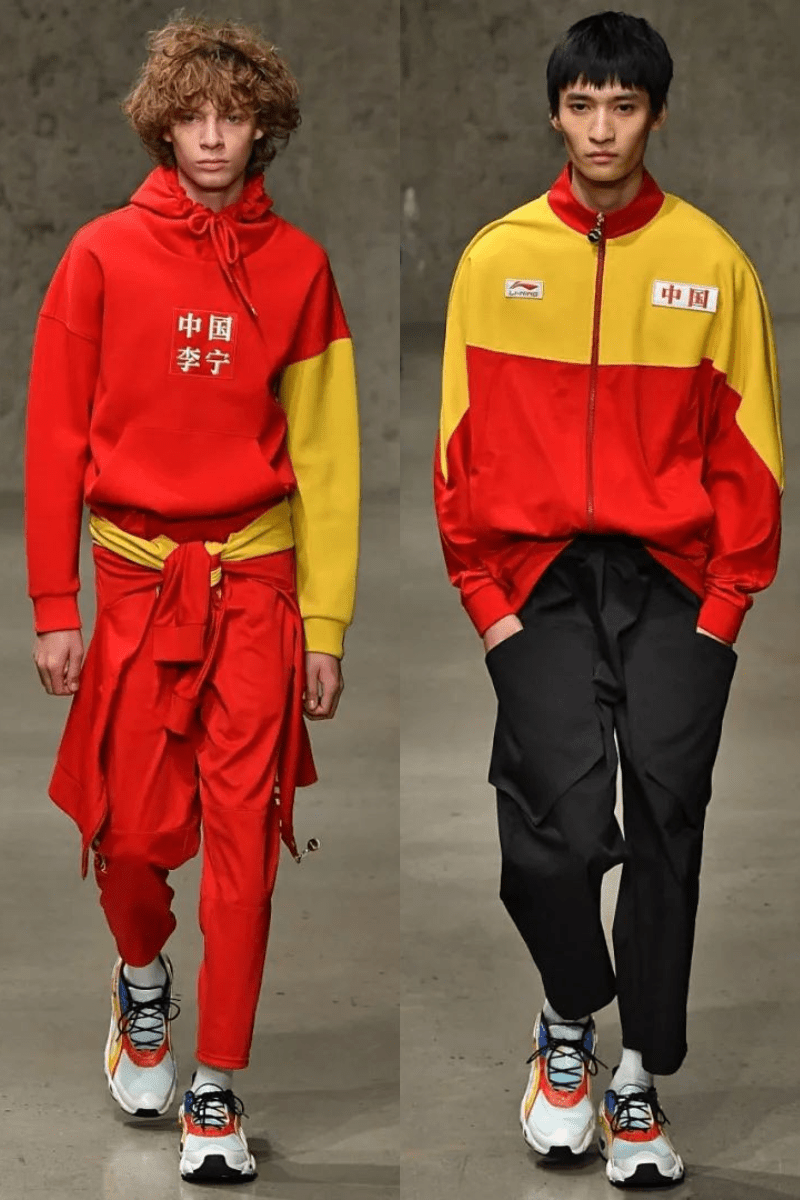Algorithmic Style Intelligence: Digital Curation Through Community Validation
The artificial intelligence embedded within Weibo's trend identification systems demonstrates computational sophistication that rivals traditional fashion forecasting services provided by industry consultancies with decades of market research experience. Machine learning algorithms process user engagement patterns, styling documentation, and aesthetic preferences to generate trend predictions that often exceed the accuracy of conventional fashion industry forecasting methods. This technological approach to style curation creates more responsive trend development than isolated designer intuition or standardized industry prediction systems can provide.
The platform's visual recognition capabilities enable users to document specific construction techniques and styling applications through image tagging and community discussion systems. When users photograph particularly well-executed armscye construction or demonstrate interest in specific princess seam applications, the algorithm creates searchable content that educates communities about technical quality standards while connecting them with similar styling innovations available through social commerce integration.
Professional wardrobes evolved past the obvious trend following of the early 2000s—shouldn't fashion forecasting evolve to prioritize authentic community intelligence over manufactured industry narratives? The recommendation system connects users with similar aesthetic preferences and construction quality standards, creating natural market segmentation that traditional fashion marketing struggles to achieve through demographic analysis alone.
Community Validation: Peer-Driven Fashion Intelligence
The social validation mechanisms embedded in Weibo create natural fashion curation without traditional industry gatekeeping systems. Users share detailed styling analysis, construction assessments, and trend documentation that create comprehensive fashion intelligence exceeding what individual expert opinion can provide. This community-driven authentication operates more effectively than traditional fashion criticism because it relies on actual user experience rather than brief editorial encounters with sample garments or theoretical trend projection.
Weibo's comment systems enable technical discussions about construction methods, styling techniques, and trend development that create informal educational networks around fashion quality and innovation. Users document styling processes, share fit challenges, and recommend construction modifications that improve garment performance while generating collective knowledge that benefits the broader community. These conversations generate fashion intelligence that establishes more sophisticated consumer expectations for styling innovation and trend authenticity.
Traditional fashion authority relied on institutional expertise that most consumers could not access directly. Weibo community validation democratizes fashion assessment by leveraging collective user experience and technical knowledge sharing that creates more comprehensive styling evaluation than individual expert opinion alone can achieve.
Technical Documentation Through Visual Storytelling
The content creation tools within Weibo enable users to document styling details with precision that rivals professional fashion photography and editorial presentation. Close-up images of hand-canvassed floating chest pieces, detailed views of bias-cut construction techniques, and step-by-step styling documentation create educational content that communicates fashion excellence more effectively than written descriptions alone.
Users leverage the platform's annotation features to identify specific construction elements—pointing out quality indicators like genuine buttonholes, explaining the benefits of floating canvas construction, demonstrating how proper fit accommodation affects overall styling success. This technical documentation approach parallels how superior bespoke tailoring communicates quality through visible construction details rather than relying on brand reputation or marketing claims alone.
Modern fashion education benefits from this visual documentation approach that makes complex styling techniques accessible to broader audiences. The technical precision required for sophisticated garment construction becomes understandable when demonstrated through sequential photography and community explanation rather than relying solely on formal educational institutions or traditional industry apprenticeship systems.
The Reset Button: Redefining Fashion Authority Through Digital Innovation
Traditional fashion influence developed when institutional authorities controlled access to trend information and styling education, but social platforms fundamentally alter how fashion knowledge circulates within consumer communities. Weibo users experience fashion discovery that feels authentic rather than commercially manufactured, creating new definitions of style authority that prioritize genuine community experience over institutional validation or celebrity endorsement systems.
The reset button mentality applied to fashion authority creates opportunities for authentic trend development that maintains quality standards while eliminating unnecessary gatekeeping mechanisms. Weibo demonstrates that communities can generate more accurate trend prediction and styling innovation when given appropriate platforms and validation systems, provided that technical knowledge and authentic experience remain priority considerations throughout the evaluation process.
This approach challenges traditional fashion industry models that depend on institutional authority to justify trend legitimacy and styling standards. Weibo success suggests that consumers value authentic peer experience and technical transparency over manufactured authority when given genuine alternatives. Traditional fashion gatekeeping is the commercial equivalent of using a BlackBerry in 2025—technically functional but fundamentally misaligned with contemporary information sharing capabilities and consumer expectations.
Platform Architecture: Technical Infrastructure Supporting Fashion Intelligence
Weibo's integration of visual discovery, social validation, and commerce functions creates a unified platform that accommodates contemporary fashion consumption patterns more effectively than separated traditional systems. The seamless transition between trend discovery, peer consultation, styling education, and purchase decision-making mirrors natural fashion shopping behaviors that prioritize community input and technical verification over individual aesthetic judgment alone.
The technical architecture underlying Weibo enables fashion intelligence that feels socially embedded rather than commercially isolated. Users access styling inspiration, construction education, and quality assessment within the same platform used for social interaction and community participation. This integration creates natural fashion knowledge development that traditional fashion retail systems struggle to replicate through conventional e-commerce approaches or isolated social media implementations.
Modern fashion commerce benefits from platform integration that supports authentic community preferences rather than forcing adaptation to artificial commercial frameworks. The floating canvas technique used in superior bespoke construction works because it allows natural drape rather than imposing rigid structure—successful fashion platforms operate on similar principles by facilitating rather than constraining authentic style development and technical knowledge sharing.
Economic Transformation Through Direct Community Intelligence
The elimination of traditional fashion intermediaries through Weibo creates economic opportunities for both emerging designers and fashion consumers that conventional industry distribution systems actively prevent. Emerging designers access authentic community feedback and trend intelligence without requiring institutional validation or expensive market research services. Consumers discover quality construction and authentic styling without depending on traditional fashion media or celebrity endorsement for validation.
Direct community intelligence enables more efficient fashion development that responds to actual preferences rather than projected trends based on incomplete market research. This community-mediated model creates sustainable design opportunities for creators who possess technical skills and authentic style perspective but lack access to traditional fashion industry infrastructure or validation systems.
The economic efficiency gained through direct community intelligence enables more responsive fashion development that maintains quality standards while eliminating artificial trend manipulation designed to drive consumption rather than satisfy authentic consumer preferences. Fashion becomes more accessible to people who appreciate technical construction and authentic design but cannot afford traditional fashion retail pricing that includes substantial marketing and institutional validation overhead costs.
Microtrend Acceleration: Rapid Style Evolution Through Digital Networks
Weibo's algorithmic amplification creates microtrend development cycles that compress traditional fashion season timelines from months to days or hours. Styling innovations documented by individual users can achieve global influence within hours of initial posting, creating fashion influence velocity that traditional industry systems cannot match through conventional seasonal presentation schedules or celebrity styling campaigns.
The platform's viral mechanics enable rapid style iteration and community refinement that accelerates fashion evolution while maintaining quality standards through peer validation processes. Users document styling experiments, receive community feedback, and refine approaches in real-time cycles that create more responsive fashion development than traditional industry systems allow through seasonal collection development and retail distribution timelines.
This acceleration creates opportunities for authentic fashion innovation that bypasses traditional industry barriers while maintaining community quality standards through transparent peer review processes. Microtrends develop through genuine community interest rather than manufactured marketing campaigns, creating more sustainable fashion influence that reflects actual consumer preferences and technical appreciation.
The Thick Skin Philosophy: Building Resilient Fashion Communities
The thick skin approach to fashion community development—building authenticity and technical knowledge into fundamental platform operations rather than treating these elements as promotional afterthoughts—appears throughout successful Weibo fashion content. Users must establish genuine credibility within communities that possess sophisticated fashion knowledge and extensive styling experience developed through years of international brand exposure and technical education.
Weibo fashion influencers succeeding within the platform demonstrate resilience by prioritizing actual construction knowledge and authentic style development over superficial trend promotion or manufactured aesthetic authority. This approach creates sustainable influence that improves through community feedback and technical education rather than depending on artificial fashion authority or manufactured trend manipulation to maintain follower engagement and commercial effectiveness.
The thick skin philosophy translates to fashion communities that anticipate and accommodate sophisticated peer evaluation while maintaining authentic technical standards throughout all content creation and trend development. Rather than creating fragile fashion authority that depends on information asymmetry or consumer naivety, successful Weibo fashion content builds credibility that benefits from transparent quality assessment and community validation processes.
Advanced Integration: AI-Powered Fashion Intelligence Systems
The artificial intelligence systems powering Weibo's fashion trend identification demonstrate computational sophistication that exceeds traditional fashion forecasting capabilities while maintaining cultural sensitivity and aesthetic intelligence that purely algorithmic systems often lack. Machine learning processes community preferences, construction quality standards, and cultural context to generate trend predictions that feel community-curated rather than mechanically calculated.
Advanced pattern recognition identifies styling techniques, construction elements, and design innovations that align with community preferences while maintaining educational value about technical excellence and quality indicators. This AI-powered curation creates learning experiences that enhance community knowledge while facilitating authentic fashion discovery rather than manipulative marketing designed to drive consumption regardless of actual preference alignment or technical merit.
Contemporary fashion development benefits from artificial intelligence that supports authentic community education and preference development rather than exploitation of psychological purchasing triggers or trend manipulation designed to drive unnecessary consumption. The technical precision required for superior garment construction—pattern accuracy, seam placement, proportional mathematics—parallels how effective AI systems process community data to enhance rather than manipulate fashion decision-making processes.
Global Integration: Chinese Innovation in International Fashion Systems
The success of Weibo fashion intelligence suggests models that could transform international fashion development and trend forecasting approaches worldwide. Western fashion institutions observing Weibo effectiveness recognize opportunities to create more authentic consumer relationships while maintaining quality standards through community engagement that prioritizes cultural sensitivity and technical transparency over traditional industry authority systems.
The integration of AI-powered curation, community validation, and cultural authenticity that defines successful Weibo fashion intelligence offers templates for international fashion development that benefits both designers and consumers globally. These approaches enable genuine fashion democratization that maintains quality standards while eliminating unnecessary barriers preventing authentic fashion appreciation and access across diverse cultural contexts.
International fashion markets can learn from Weibo digital innovation without cultural appropriation by focusing on underlying principles that improve authentic consumer intelligence and technical quality transparency. Community validation, AI-powered education, and cultural sensitivity represent universal improvements to fashion development that enhance authenticity regardless of specific platform implementation or regional market characteristics.
Contemporary Applications: Western Integration of Digital Innovations
Modern fashion development can incorporate Weibo intelligence innovations without cultural appropriation by understanding underlying principles that improve authentic community engagement and technical quality communication. AI-powered curation, community validation, and digital quality verification represent improvements that enhance fashion development effectiveness regardless of specific platform implementation or cultural styling preferences.
The community-driven intelligence that powers Weibo fashion success translates to Western contexts through user-generated content systems, peer validation networks, and educational platforms that prioritize technical knowledge over institutional authority. These applications enhance contemporary fashion development while respecting the cultural contexts that developed these sophisticated digital fashion intelligence approaches.
Contemporary fashion education can integrate analysis of Weibo innovation into curricula that address global fashion development alongside traditional industry methods. Students gain appreciation for digital innovation while learning applications that enhance their understanding of fashion development dynamics and authentic consumer engagement across different technological and cultural contexts.
Future Evolution: Digital Democracy in Global Fashion Intelligence
The intersection of Weibo innovation and international fashion development suggests future possibilities that could transform how fashion trends develop and quality standards emerge globally. The AI sophistication and community authenticity that enable Weibo success provide templates for creating authentic fashion democracy that maintains quality standards while eliminating unnecessary institutional barriers to consumer intelligence and technical knowledge.
Advanced fashion intelligence platforms incorporating community validation and technical documentation capabilities could enable global fashion development that operates more effectively than traditional institutional forecasting systems. These platforms could provide authentic consumer intelligence while maintaining quality standards through peer engagement rather than institutional gatekeeping that often prioritizes commercial interests over authentic consumer benefit and technical knowledge development.
The global networks developing around community fashion intelligence create opportunities for cultural exchange that benefits both designers and consumers through improved responsiveness and technical knowledge development. Practitioners can study Weibo innovation while contributing to evolution of these methods for international applications, creating sustainable models for fashion democracy in community intelligence contexts.
Contemporary fashion development informed by Weibo innovation represents evolution that honors authentic community intelligence while addressing global market requirements. The platform logo surrounded by viral styling moments and trending fashion topics embodies trend intelligence transformation that makes fashion development genuinely responsive while maintaining quality standards and technical knowledge that artificial institutional systems cannot replicate effectively.
The community validation visible through Weibo platforms—peer styling analysis, shared construction experience, collective quality assessment—demonstrates possibilities for fashion development that enhances consumer intelligence rather than exploiting information asymmetry. The democratization occurring through these platforms creates sustainable models for fashion intelligence that benefits creators and consumers through authentic knowledge exchange rather than manufactured trend manipulation or institutional gatekeeping systems.




